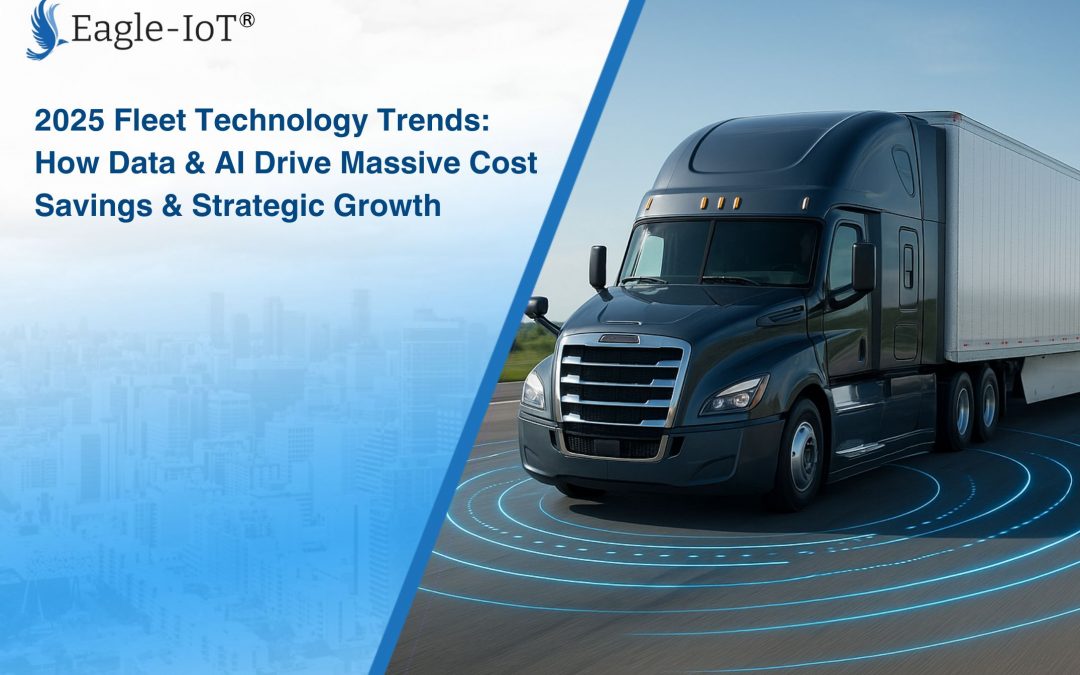Fleet technology is emerging as a critical enabler of efficiency, safety, and sustainability. The 2025 Fleet Technology Trends Report, based on a diverse survey of executives, upper management, and fleet managers across government, transportation, and freight sectors, provides a panoramic view of the advancements in fleet telematics. By leveraging robust data and innovative analytics, fleets are now better equipped to optimize operations, reduce costs, and make strategic decisions. This article explores the report’s findings, with a particular focus on how reported cost savings are transforming fleet operational strategies, from enhanced decision-making to improved safety and sustainability.
Data-Driven Decision Making in Fleet Technology
At the core of modern fleet management lies the power of data. The report emphasizes that advanced technologies, such as GPS fleet tracking and AI-driven systems, are revolutionizing how fleet managers approach daily operations. Enhanced data accuracy and deeper insights now enable evidence-based decisions that directly influence operational efficiency and safety. With real-time tracking and advanced analytics, fleet managers can proactively adjust routes, anticipate maintenance needs, and fine-tune driver performance—ensuring that every decision is backed by solid data.
The Integration of AI, Machine Learning, and Predictive Analytics
The evolution of fleet technology is marked by the integration of AI, machine learning, and predictive analytics. These technologies have transitioned from being cutting-edge to standard components of modern telematics systems.

AI-powered video telematics, for instance, facilitates individualized driver coaching and the development of personalized safety plans, significantly reducing accident rates. Moreover, predictive analytics helps forecast maintenance needs and operational disruptions, thereby minimizing downtime. Such proactive approaches not only extend vehicle lifespans but also lead to a more reliable and efficient fleet—a transformation that is essential in today’s competitive market.
Overview of Survey Respondents and Technology Adoption Trends
The survey underpinning the report gathered insights from a balanced mix of fleet executives, upper management, and operational managers. The respondents, drawn from diverse sectors including government, transportation, and general freight, collectively underscore the widespread adoption of fleet technology. Among the various technologies, GPS tracking emerged as the most prevalent, closely followed by in-cab video systems and field service management solutions. This broad-based adoption signals that fleets across all industries are recognizing the value of technology-driven enhancements, particularly in the context of cost reduction and operational efficiency.
Mitigating Persistent Cost Challenges with Fleet Technology
One of the report’s recurring themes is the persistent challenge of rising operational costs—a concern noted by 77% of survey respondents for the fifth consecutive year. Increasing expenses, particularly in fuel, accidents, and labor, are significant hurdles for fleet operators.

However, the integration of fleet technology has begun to turn the tide. GPS fleet tracking, in particular, has proven to be an indispensable tool for mitigating these costs. By reducing fuel consumption, lowering accident rates, and curbing labor expenses, technology is delivering a faster return on investment. Moreover, the enhanced accuracy of predictive analytics enables fleet operators to anticipate and prevent costly downtime, ensuring that fleets remain both competitive and financially resilient.
Impact of Reported Cost Savings on Fleet Operational Strategies
The data from the report reveal that the cost savings achieved through modern fleet technology have far-reaching implications on operational strategies. These savings manifest in several transformative ways:
Enhanced Decision-Making:
With improved data accuracy and deeper insights from technologies like GPS fleet tracking and AI, fleet managers are empowered to make strategic, evidence-based decisions. These decisions not only enhance operational efficiency but also bolster overall safety protocols, ensuring that every aspect of fleet management is optimized.
Budget Reallocation:
The report highlights significant savings—fuel costs reduced by 16%, accident costs by 22%, and labor costs by 16%. These savings enable fleets to reallocate budgets toward critical areas such as technology upgrades, driver training programs, and fleet expansion. By reinvesting these funds, fleets can boost performance, adopt newer technologies, and maintain a competitive edge.
Focus on Sustainability:
Lower fuel and maintenance costs contribute to a more efficient operation, which in turn reduces greenhouse gas emissions. This alignment with sustainability goals encourages fleets to adopt eco-friendly technologies and practices. The data underline how cost savings can directly contribute to environmental stewardship while enhancing operational efficiency.
Improved Safety and Risk Management:
A notable 22% reduction in accident and insurance costs has been reported, underscoring the role of technology in improving fleet safety. Such savings encourage the adoption of safety-oriented technologies and risk management practices. Enhanced safety profiles not only protect drivers and vehicles but also create a proactive approach toward mitigating potential risks.
Enhanced Driver Recruitment and Retention:
With cost savings generating additional capital, fleets are better positioned to offer competitive wages and benefits. This improved compensation structure aids in attracting and retaining quality drivers—a critical factor in an industry facing a significant labor shortage. Furthermore, advancements in operational efficiency and safety contribute to greater job satisfaction among drivers.
Operational Resilience:
The faster returns on investment and overall cost reductions suggest that fleets are becoming increasingly resilient. This resilience is key in navigating persistent challenges such as rising operational costs and strict regulatory pressures. Fleets that can adapt quickly to market fluctuations and regulatory changes are better positioned to sustain long-term success.
These insights, drawn from various pages of the report (Pages 8, 11, 2, and 6), illustrate how cost savings are not just a financial metric but a strategic enabler for fleets aiming to remain agile and competitive in a challenging market.
Staying Ahead of Maintenance with AI
Modern fleet management solutions are now leveraging AI and machine learning to anticipate maintenance requirements with remarkable precision. This forward-looking approach allows fleets to schedule maintenance intervals based on real-time data rather than fixed timetables.
As a result, fleets can avoid unexpected breakdowns, extend vehicle lifespans, and reduce overall maintenance costs. Additionally, for fleets working toward electric vehicle (EV) integration and sustainability, predictive maintenance supported by AI is vital in achieving both operational and environmental objectives. This proactive maintenance strategy is emerging as a cornerstone of resilience in fleet operations.
The Multifaceted Benefits of GPS Fleet Tracking
GPS fleet tracking remains the most widely adopted technology, and its benefits extend well beyond real-time location monitoring. Modern GPS systems offer comprehensive vehicle diagnostics that allow fleet managers to reduce downtime, optimize route planning, and improve overall vehicle performance. For drivers, these systems not only facilitate efficient routing but also contribute to enhanced productivity and job satisfaction. The integration of GPS data with AI and predictive analytics creates a feedback loop that continuously refines operational strategies—resulting in safer, more efficient, and more cost-effective fleet management.
Leading Technologies: Dashcams, Asset Tracking, and Field Service Management
While GPS tracking continues to be the flagship technology, other innovations such as in-cab dashcams and asset tracking solutions are gaining prominence. In-cab dashcams, for example, are proving to be a long-term investment with 68% of users finding them extremely or very beneficial. Nearly half of these users reported a positive return on investment within the first year, largely due to reduced accident and insurance costs. Similarly, asset tracking solutions enhanced with predictive analytics are allowing fleets to optimize asset utilization, security, and productivity. Field service management solutions, which streamline job dispatch and communication, have been instrumental in improving scheduling and operational efficiency in sectors like transportation, construction, and distribution.
The Bottom Line
The 2025 Fleet Technology Trends Report unequivocally demonstrates that the convergence of data, AI, and advanced telematics is reshaping the fleet management landscape. Cost savings achieved through these technologies are not merely financial metrics—they represent a fundamental shift toward more efficient, strategic, and safety-focused operations. By enhancing decision-making, enabling budget reallocation, promoting sustainability, improving safety, and bolstering driver recruitment and retention, these technologies empower fleets to navigate the complexities of a competitive market with greater resilience.
In conclusion, as fleet technology continues to evolve, the strategic use of data and advanced analytics is proving to be the linchpin of modern fleet management. The cost savings and operational improvements outlined in the report underscore the transformative potential of telematics and AI. For fleet managers and operators, investing in these technologies is not just a matter of staying current—it is a strategic imperative for long-term success.


